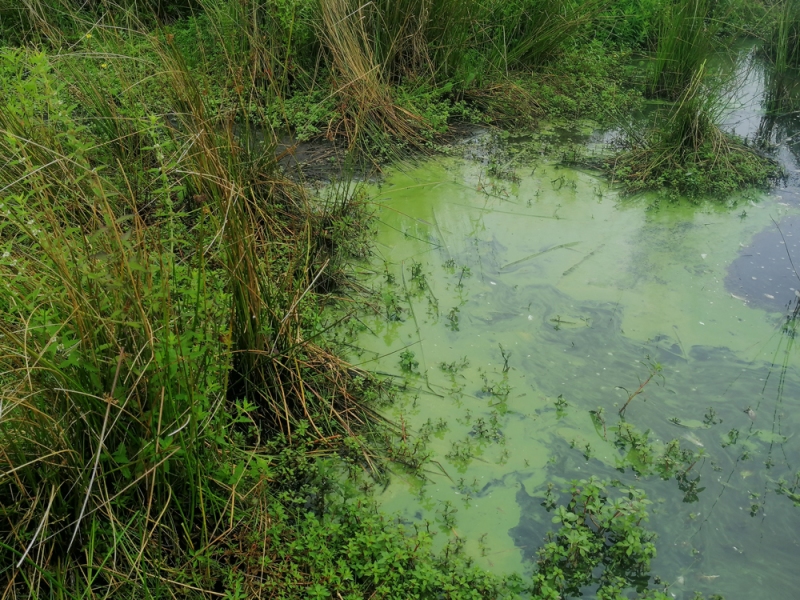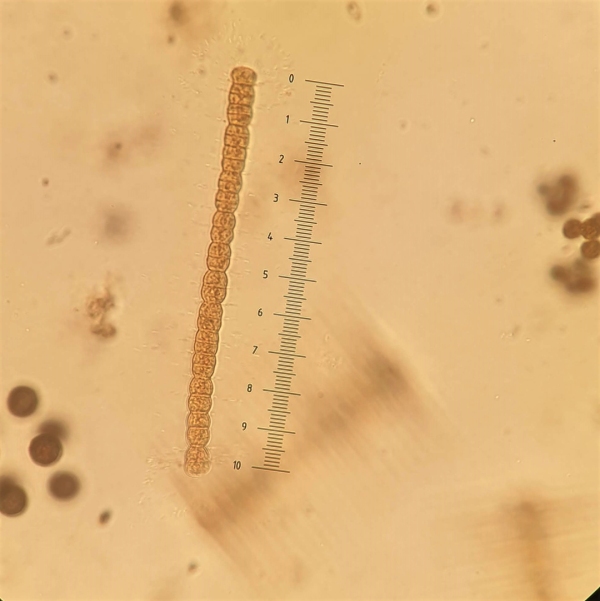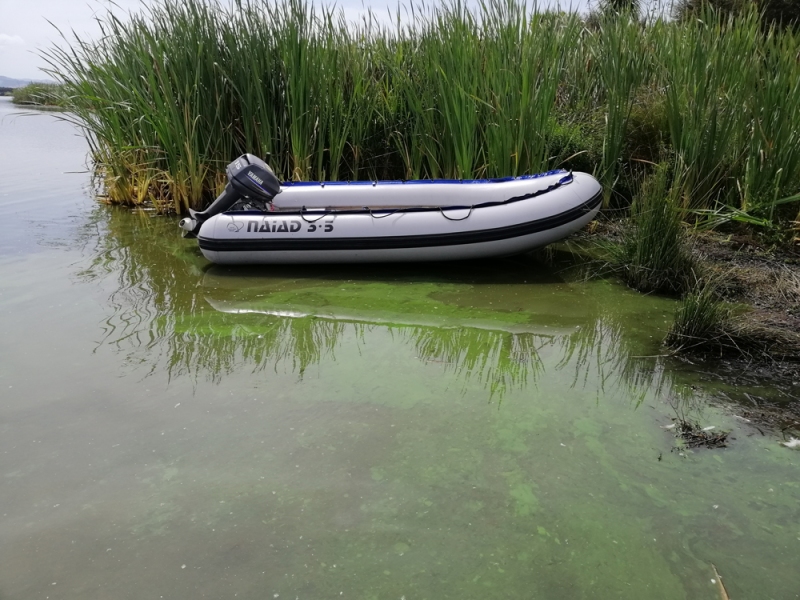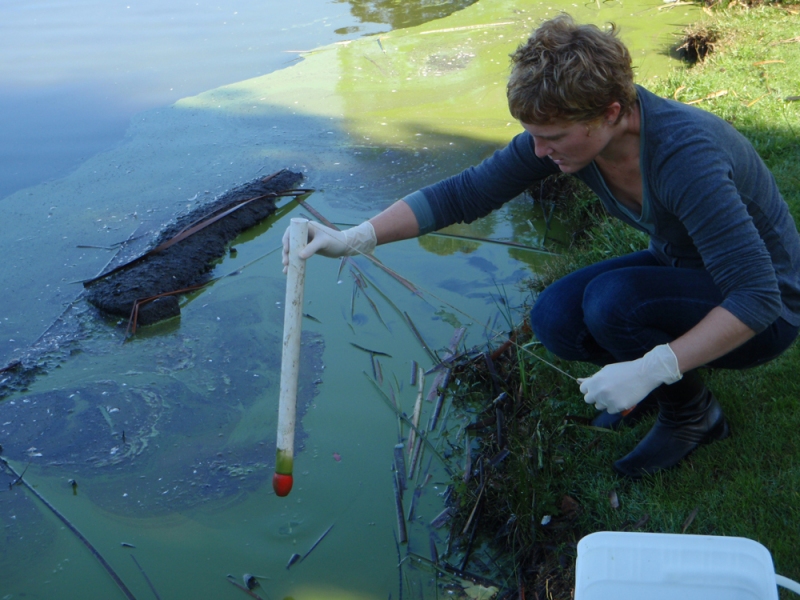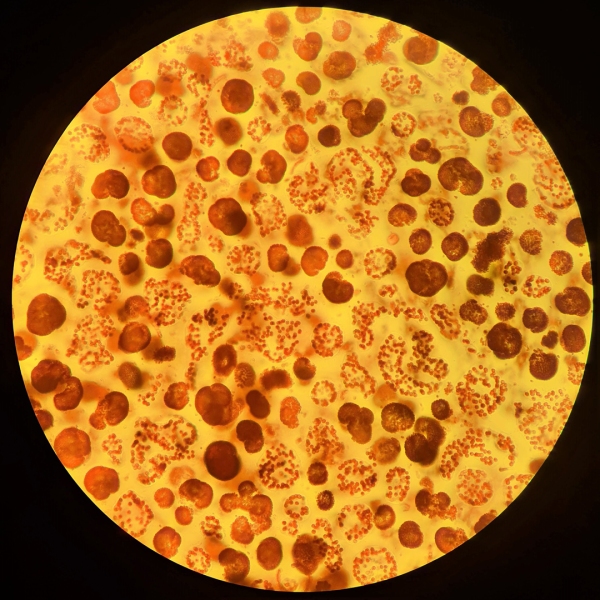Blooms of hazardous cyanobacteria (blue-green algae) in rivers, lakes and reservoirs can pose high risk to human and animal health. How can you find out whether an algal bloom is potentially toxic?
Do you have an algal problem? Is the bloom potentially toxic? Do the cyanobacteria concentrations exceed health guidelines for drinking-water, stock water or recreation? Does your water have a taste or odour problem? NIWA Algal Services may well be able to help.
Since 2004, NIWA has operated a laboratory specialising in the analysis of cyanobacteria and other algae, which provides a one-stop shop for algal counts and toxin testing.
Algal Services is accredited by International Accreditation New Zealand (IANZ) for cyanobacterial identification and counts for potable and non-potable waters. Our services are provided to many sectors including local, regional, and national government, health authorities, industry, and farmers. We offer four main analyses and several additional services which meet most requirements, or we can tailor services to meet specific needs. Our goal is to provide you with the service you want and the information you need.
We provide analysis for samples from:
- Lakes
- Rivers
- Streams
- Drinking water supplies
- Irrigation reservoirs
- Stock water dams/troughs
- and more.
Analysis options
Standard analysis
Is this water safe to drink/use?
Recommended for on-going phytoplankton monitoring of municipal/ industrial water supply, recreational waterbodies, and stock water supplies.
- Identification and enumeration (cells per mL) of observed potentially toxic cyanobacteria taxa and other dominant (i.e. ~90% of biomass) algal species
- Identification to species level where possible
- Sample turnaround 5 working days
- Reported in .pdf format via email
- Basic advice and information on sample collection/handling/delivery and reported results
Full analysis
How is this system changing over time?
This comprehensive analysis is recommended when data for all phytoplankton species within a sample is required e.g. State of the Environment monitoring.
- Identification and enumeration (cells per mL) of observed potentially toxic cyanobacteria taxa and all other algal species
- Identification to species level where possible
- Sample turnaround 5 working days
- Reported in .pdf format via email
- Basic advice and information on sample collection/handling/delivery and reported results
Base analysis
Why does the water look, smell, taste like that?
Recommended for one-off phytoplankton sampling events e.g. ornamental ponds, farm dams, private water supplies.
- Identification and abundance rank of observed potentially toxic cyanobacteria and other dominant algal species
- Sample turnaround 5 working days
- Reported in .pdf format via email
- Basic advice and information on sample collection/handling/delivery and reported results
Periphyton analysis
What’s growing on that rock?
Recommended analysis for identifying dominant taxa within algal matts or filamentous surface growth in a waterbody or system.
- Identification and abundance rank of benthic cyanobacteria taxa and other dominant (i.e. ~90% of biomass) periphyton species present within a supplied sample
- Identification to species level where possible
- Sample turnaround 5 working days
- Reported in .pdf format via email
- Basic advice and information on sample collection/handling/delivery and reported results
Additional services
Express
Express analysis provides a 48-hour turnaround, recommended when cyanobacteria concentrations are expected to be approaching or exceeding guideline/standard levels (e.g. during a bloom event) or for urgent analysis on a weekend/statutory holiday.
Cell biovolumes
Biovolume is calculated to assess the relative abundance (as biomass or carbon) of the various shaped and sized algae within a sample. Cyanobacteria biovolumes can be used to indicate the potential for toxin hazard. This analysis is particularly helpful when there are high concentrations of very small cyanobacteria species. Cell biovolumes can be provided for both cyanobacteria and other algal species identified within a sample.
Cyanotoxin testing
We can arrange for samples to be forwarded to an external IANZ accredited laboratory for relevant cyanotoxin (microcystin, anatoxin, homoanatoxin-a, cylindrospermopsin, nodularin and saxitoxins) analyses.
Alternative report formatting
A .CSV file or other agreed reporting format can be provided.
Trend graphing
Our trend graphs are aimed to help you interpret your data over a monitoring season.
Expert advice
When appropriate we provide basic information and answer simple questions that relate to reported results free of charge. We can also answer more complex questions, aid interpretation of results, and provide expert advice on bloom management and the design and implementation of monitoring programmes.
NIWA scientists were involved in some of New Zealand’s earliest lake restoration projects. We can help you with long-term solutions. Call NIWA if you would like to know more, or to arrange a sampling kit and analysis. Algal samples need special treatment, so call us first to find out about sample collection, handling, and transport. Our chain of custody sampling form can be downloaded below.
Algal Services expertise
Karl Safi is a scientist with thirty years of expertise is in freshwater and marine phytoplankton taxonomy and monitoring. Karl’s responsibilities include: project director, taxonomic overview, IANZ accreditation and training of other staff. He is also working on improving methods of cyanobacterial assessment and recently was the lead writer of The National Environmental Monitoring Standards (NEMS), Planktonic Cyanobacteria, 2023. Karl’s marine research covers algal taxonomy, microzooplankton, microzooplankton grazing effects on carbon flows and understanding the role of, and processes within, the microbial food web.
Helen Brider is an Algal Ecology Technician with eighteen years experience in freshwater phytoplankton taxonomy and monitoring. Helen is Project Manager for Algal Services, whose responsibilities include: taxonomic overview, IANZ accreditation, maintaining Key Technical Personnel status and training of other staff. Helen has participated in numerous international freshwater cyanobacteria and algal identification courses and undertaken local training with periphyton species and the problematic algae Didymo. In 2020 Helen won the NIWA Excellence Customer Focus Award.
Karen Thompson has been a member of Algal Services since 2004 and is one of the teams Key Technical Personnel. Karen prepared and documented policies and procedures for the Services first successful IANZ accreditation in 2009. Karen has participated in international freshwater cyanobacteria and algal identification courses and was involved in presence surveys and the Gemex™ efficacy river trial for the pest alga Didymosphenia geminata. Karen has vast experience in microalgae culture techniques and also uses flow cytometry to enumerate phytoplankton. In 2019 she won the Laboratory Technologist Award at the 13th Annual Kudos Awards.
Mashanta Mohsin is a Phytoplankton and Ecotoxicology Technician with experience in freshwater phytoplankton taxonomy and monitoring. Mashanta is a Key Technical Person. Mashanta’s key responsibilities include analysis and reporting of drinking water and recreational samples, IANZ accreditation and calibration of equipment. Mashanta has participated in an international course on cyanobacteria identification and has experience in micro and filamentous algae culture techniques. Mashanta is involved in research aiming to biologically treat diffused pollutants and wastewater using NZ native filamentous algae.

